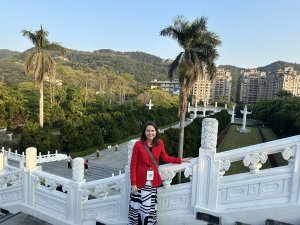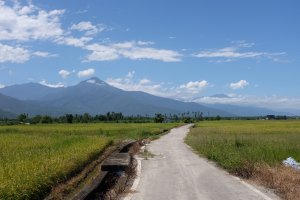In this two-part essay, I survey two important academic lineages in Taiwan and their contributions to the study of Chinese Buddhist poetry. In the first part, I focused on the cohort of scholars that worked and trained at National Chengchi University. In this second part, I examine the other major lineage. In addition to tracing the origins of this second group, I highlight some recent works and offer a more in-depth summary of their contents.
The other major school of scholarship on Buddhist poetry is associated with National Taiwan Normal University (NTNU) and National Taiwan University (NTU). Though still connected to traditions of East Asian scholarship, these scholars distinguish themselves through their engagement with contemporary Western scholarship. They frequently refer to their distinctive style of scholarship as cultural analysis.
These scholars tend to ground their work in historical disciplines (intellectual history, literary history, social history) rather than pure philosophy or literary analysis. They also set themselves apart by looking beyond the received canon. Though not as numerous as the members of Chengchi school of thought, the NTNU-NTU practitioners of cultural analysis are influential and hold positions at Taipei’s three most prestigious institutions: Academia Sinica, National Taiwan Normal University, and National Taiwan University.
The NTNU-NTU school of thought may be traced back to Ba Hutian (巴壺天), who lived from 1905 to 1987. After coming to Taiwan in 1949, Ba served as professor of Chinese literature at NTNU, where he lectured on Tang and Song poetry. Professor Ba is remembered, however, as a Buddhist intellectual. Many of his mid-career and late-life publications concern Chan literature and philosophy. After a period in Singapore, Professor Ba taught at NTU for a decade beginning in the 1970s.
Scholars today often refer to Ba’s two collections of essays: Yihai Weilan (藝海微瀾), published in 1971, and Changu Shixin Ji (禪骨詩心集), published in 1988. Many of Ba’s insights still stand after decades of further scholarship, such as his essay, “Chanzong Sanguan yu Zhuangzi ” (禪宗三關與莊子), which appears in Yihai Weilan. It discusses the Chan “three gates” and their connection to Zhuangzi, the fountainhead of literary Daoism.
Ba had a somewhat itinerant career, not spending his tenure at a single institution. He did not train a large cohort of graduate students. Instead, Professor Ba involved himself in the Buddhist community in Taiwan. In addition to inspiring current students of Buddhism, Professor Ba is also remembered by the Buddhist community as a prominent lay Buddhist.
In the next generation after Professor Ba, two professors stand out. At NTU, many students have studied Buddhist philosophy with Yang Huinan (楊惠南). Professor Yang is appreciated by a generation of NTU students. On the subject of Buddhist poetry, his monograph Chansi yu Chanshi (禪思與禪詩) was published in 1999 and explores Buddhist ideas of emptiness and wisdom as expressed in poetry. In addition to his scholarship, Yang also possesses a gifted literary spirit. Since his retirement, Yang has been an influential member of Taiwan’s contemporary literary circles and a reformer in Taiwan’s Buddhist sangha.
The other outstanding professor of this generation is Professor Wang Kaifu (王開府) of NTNU. Professor Wang has been an integral part of the NTNU Department of Chinese since he joined the faculty in the mid-1970s. Still active today, he supervised an entire generation of graduate students. Wang has taught and advised graduate students who work on topics as diverse as Tang dynasty literature, early Chinese translations of Indian Buddhist scriptures and Buddhist philosophy, while his own publications have focused on Chinese philosophy and Buddhism. His most well-known students are scholars of Chinese Buddhism. Most of the students Wang produced excel at drawing on models from Chinese literary studies. To view at a glance Professor Wang’s influence on his students’ work, one can peruse the table of contents of the Festschrift compiled by his students to mark his retirement last year: Fojiao yu Zhongguo Wenhua: Wang Kaifu Jiaoshou Rongtui Jinian Lunwen Ji (佛教與中國文化:王開府教授榮退紀念論文集).
Another person tangentially related to students of this period was Tu Sungpo (杜松柏). His tenure at NTNU during the 1980s was unfortunately short. His influence on the study of Buddhist poetry is limited to his excellent doctoral dissertation, published as the monograph Chanxue yu Tang Song Shixue (禪學與唐宋詩學) in 1976.
The most exciting scholarship for Western readers to explore, from my vantage point, belongs to three near-contemporaries in Taiwan. These three scholars, at NTU, NTNU, and Academia Sinica, cover different topics and periods of history, but all refer to each other’s work. Below, I will offer more detail and a summary of their work.
The earliest publication on Buddhist poetry I have found that refers to cultural analysis was written by Professor Hsiao Li-hua (蕭麗華). Professor Hsiao earned her doctorate from NTU and has been a professor in the NTU Department of Chinese Literature. Her Tangdai Shige yu Chanxue (唐代詩歌與禪學), published in 1997, marked a break from earlier studies. Her approach deviated from earlier attempts to assemble a canon of Buddhist poetry and poetics.
Professor Hsiao instead focused on situating historical phenomena in varied contexts of intellectual and literary history. She pioneered the study of Buddhist poetry as literary history in Taiwan. In the aforementioned collection of essays, Hsiao focuses each chapter on a single question. The second chapter, for example, examines what the word “Chan” meant to poets of the Tang.
Hsiao’s monograph has played an important role in bridging traditional literary studies and Buddhist studies. She notes in her preface to the 1997 edition that mainstream scholarship had focused on the received canon and “ignored shifts in cultural history such as intellectual, social, and religious history.” Hsiao’s own teachers were interested in the historical circumstances of literary production and its cultural implications, and they often excluded discussions of aesthetics. Hsiao describes her method as “using cultural analysis to close-read poems.” (Hsiao, 1997: Zixu 自序, pp 1-3.)
One cannot help but compare Hsiao’s 1997 compilation to contemporary mainland scholar Sun Changwu’s (孫昌武) 1997 monograph Chan Si yu Shi Qing (禪思與詩情), published the same year in Beijing. Sun’s massive work follows a similar organizational principle. Sun’s work has been similarly important and influential in Sinophone scholarship.
Professor Hsiao’s follow-up book was published earlier this year (though it carries a 2012 imprint date). It continues her analytic program and extends her literary history up through the major developments of the Song Dynasty. Wenzi Chan Shixue de Fazhan Guiji (「文字禪」詩學的發展軌跡) picks up where Hsiao’s first monograph left off, with the poet-monks of the Five Dynasties and the increasingly important figure of the monk Jiaoran. The middle section of essays focus on the writing of the genius Su Shi and the monk Huihong; Hsiao concludes with an examination of the Canglang Shihua (滄浪詩話) and an exploration of Wenzi Chan in Buddhism today.
I understand that after her retirement from NTU next year, Professor Hsiao plans to move to Fo Guang University (佛光大學) to direct a large project focused on Chinese Buddhist literature.
Huang Jingjia (黃敬家) is the most prominent young scholar following in Hsiao’s footsteps. She is considered one of Hsiao’s students. Huang earned her PhD at NTNU under Wang Kaifu. She was recently appointed associate professor in the Chinese Department at her alma mater. Huang’s work builds neatly atop Hsiao’s scholarship. Huang, like Hsiao, borrows concepts from Western literary analysis, places her subject in historical contexts, and excels at close-readings of text. Huang’s 2011 book, Shi-Chan Kuang-Chan Nü-Chan: Zhongguo Chanzong Wenxue yu Wenhua Tanlun (詩禪‧狂禪‧女禪:中國禪宗文學與文化探論) was well-received by senior scholars in the field. She recently embarked on a project concerning the reception history of Hanshan “Cold Mountain” poems beginning from Song Dynasty Buddhist writing.
Professor Liao Chao-heng of Academia Sinica, my sponsor this past year, also centers his analyses around culture in his studies of late Ming and early Qing literature. Professor Liao did his early studies at NTU where he learned world literatures, Chinese literature, and creative writing. He earned his doctorate from Tokyo University, working with some of Japan’s most famous scholars, including Araki Kengo and Oki Yasushi.
Given his unique familiarity with both Chinese literature and Japanese Buddhist studies, Professor Liao has produced some of the most interesting work on the subject of Buddhist literature. His 2008 monograph Zhong-bian Shi-Chan Meng-Xi: Ming Qing Chanlin Wenhua Lunshu de Chengxian yu Kaizhan (中邊‧詩禪‧夢戲:明清禪林文化論述的呈現與開展) focuses on images in text as particular, circumstantial representations. For example, one of his most widely-read essays demonstrates the dynamic interplay between late Ming stage plays and contemporary Buddhist philosophical representations of “dream-like reality.” Professor Liao’s work destabilizes distinctions between received categories like Buddhism and Confucianism. In contrast to his colleagues who work towards defining a canon, he has been influenced by the linguistic turn in Western scholarship.
Besides the lineages of teachers in Taiwan, Taiwanese students have been influenced by the many books available from overseas and the Chinese language books from China in particular. Sun Changwu, mentioned above, has been an influential mainland author. Another interesting mainland scholar is Ge Zhaoguang (葛兆光), whose work has been well-received here in Taiwan. His 1998 monograph includes one essay that examines the uses of the image of clouds or yun (雲) in the poetry of monks. Ge contrasts those images with the meanings of a cloud in non-Buddhist poetry. Ge argues that through the eyes of Buddhist writers, the Chinese learned that the nature of a cloud is like the nature of the self: it coalesces for a period and it appears to float as an integrated individual cloud, but it soon dissipates, and not even an essence remains.
Ge’s analysis of the aesthetics of this image in Buddhist poetry is compelling, even though he has been criticized for making absolute claims, for failing to provide adequate evidence, and for using sources from disparate time periods. Some Taiwanese scholars have improved upon his method to reveal how imagery in Buddhist poetry is in dialogue with the Chinese tradition while at the same time being uniquely Buddhist.
In conclusion, I am sure that this brief overview of the Taiwanese study of Chinese Buddhist poetry has overlooked important persons, books, and research. A year under the auspices of the Fulbright has been a great privilege; however, one year is a short period of time to know a place as intellectually rich as Taiwan. It is my hope to return in the future to continue to work together with members of the Taiwanese academy.
Jason Protass is a Ph.D. candidate in religious studies at Stanford University. During his grant, he conducted research on Buddhist literature and Chinese religiosity.
Post Views: 4,551





